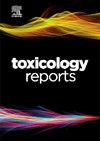丁蛋白通过抗氧化、抗炎和抗凋亡途径减轻5- fu引发的肝毒性
Q1 Environmental Science
引用次数: 0
摘要
5-氟尿嘧啶(5-FU)是一种广泛使用的化疗药物,但其潜在的肝毒性给临床带来了挑战,因为它会引起肝组织的氧化应激、炎症和细胞凋亡。丁酮,一种天然查尔酮类黄酮,具有多种生物活性,如抗癌、抗炎和抗血小板作用。本研究旨在探讨丁胺素对5- fu诱导的大鼠肝毒性的保护作用。雄性白化病大鼠分为4组(每组7只):对照组、5-FU组和2个butein预处理组(50和100 mg/kg/天,口服14 d),第14天腹腔注射单次剂量150 mg/kg 5-FU。检测血清肝酶(ALT、AST)、细胞因子(IL-6、IL-10、NF-κB)、氧化应激标志物(MDA、GSH)、TNF-α基因表达及caspase-3、NRF2蛋白水平。同时进行组织学评估。5-FU显著提高血清ALT、AST水平,提高NF-κB、IL-6、MDA、TNF-α表达,降低IL-10、GSH、NRF2水平(p <; 0.05)。组织学改变包括窦状窦扩张、充血和肝细胞变性。Butein预处理显著减弱了这些改变,其中两种剂量的Butein都显著降低了转氨酶、促炎细胞因子和氧化应激标志物,同时增强了抗氧化防御和抗炎IL-10水平。值得注意的是,高剂量Butein比低剂量更有效地恢复NRF2表达并降低caspase-3蛋白水平。组织学上,高剂量的丁胺素保留了正常的肝脏结构,病理改变很小。综上所述,通过抑制氧化应激、抑制促炎和凋亡标志物以及上调抗氧化防御,丁蛋白对5- fu诱导的肝损伤具有剂量依赖性的肝保护作用;此外,组织病理学评估进一步支持了生化和分子的发现,特别是在100 mg/kg/天的剂量下,保留了正常的肝脏结构并最大限度地减少了细胞损伤;因此,支持丁胺素在管理化疗肝毒性方面的预防潜力。本文章由计算机程序翻译,如有差异,请以英文原文为准。
Butein mitigates 5-FU-triggered hepatotoxicity via antioxidant, anti-inflammatory, and anti-apoptotic pathways
5-Fluorouracil (5-FU) is a widely used chemotherapeutic agent, but its hepatotoxic potential poses clinical challenges, as it induces oxidative stress, inflammation, and apoptosis in liver tissue. Butein, a natural chalcone flavonoid that possesses varied biological activity, such as anticancer, anti-inflammatory, and antiplatelet effects. This study aimed to evaluate the possible protective effects of Butein against 5-FU-induced hepatotoxicity in rats. Male albino rats were divided into 4 Groups (of 7 animals each): control, 5-FU, and two Butein-pretreated Groups (50 and 100 mg/kg/day, orally for 14 days) each before a single intraperitoneal dose of 150 mg/kg 5-FU, which was injected on day 14. Serum liver enzymes (ALT and AST), cytokines (IL-6, IL-10, and NF-κB), oxidative stress markers (MDA and GSH), TNF-α gene expression, and protein levels of caspase-3 and NRF2 were evaluated. Histological assessments were also conducted. 5-FU significantly elevated serum ALT and AST levels, increased NF-κB, IL-6, MDA, and TNF-α expression, and decreased IL-10, GSH, and NRF2 levels (p < 0.05). Histological changes included sinusoidal dilation, congestion, and hepatocyte degeneration. Pre-treatment with Butein markedly attenuated these alterations, where both doses of Butein significantly reduced transaminases, pro-inflammatory cytokines, and oxidative stress markers while enhancing antioxidant defenses and anti-inflammatory IL-10 levels. Notably, the high dose of Butein restored NRF2 expression and reduced caspase-3 protein levels more effectively than the lower dose. Histologically, the high dose of Butein preserved normal hepatic architecture with minimal pathological changes. In conclusoin, Butein offers dose-dependent hepatoprotection against 5-FU-induced liver injury through the attenuation of oxidative stress, suppression of pro-inflammatory and apoptotic markers, and upregulation of antioxidant defenses; moreover, the histopathological evaluation further supported the biochemical and molecular findings, particularly at the 100 mg/kg/day, which preserved normal hepatic architecture and minimized cellular damage; and, thus support the prophylactic potentialof Butein in managing chemotherapeutic liver toxicity.
求助全文
通过发布文献求助,成功后即可免费获取论文全文。
去求助
来源期刊

Toxicology Reports
Environmental Science-Health, Toxicology and Mutagenesis
CiteScore
7.60
自引率
0.00%
发文量
228
审稿时长
11 weeks
 求助内容:
求助内容: 应助结果提醒方式:
应助结果提醒方式:


